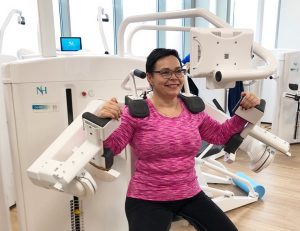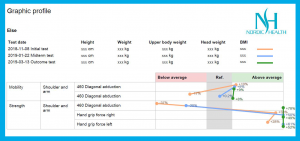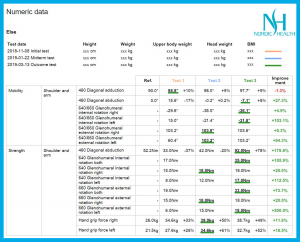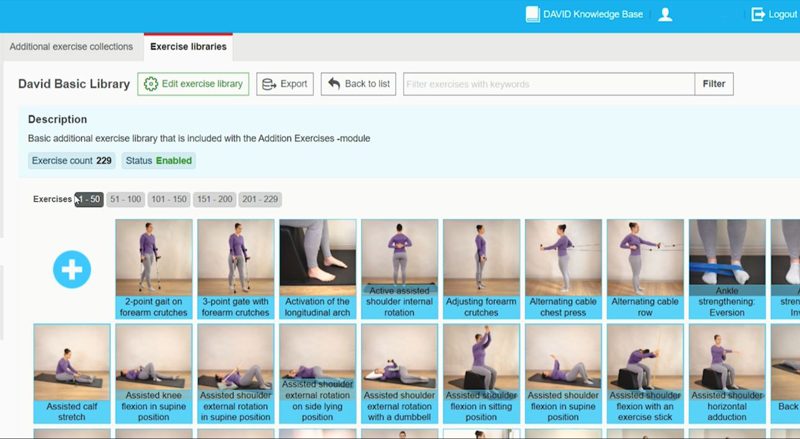Patient testimonial for shoulder rehabilitation
In late 2017, Else’s shoulder began hurting and an ultrasound examination showed supraspinatus tendonitis. The doctor gave her a cortisone injection but only gave her short term relief. In late 2018, the shoulder pain returned. To avoid this pain, Else did not use her arm normally. She returned to the orthopedist who diagnosed Else with a rotator cuff tear and shoulder calcific tendonitis. For this, she was advised to visit a physiotherapist and was given anti-inflammatory pain medication. She saw a segment on the Nordic Health clinic on TV about a scoliosis patient’s success story, and so Else decided to visit the clinic.
Different approach to reducing shoulder pain
At the clinic, Else met with the clinic’s physiotherapist, Suvi, to create an individualized treatment program. Suvi first did a clinical examination. This includes functionality and quality-of-life questionnaires which are directly integrated in the EVE platform. The ASES functionality questionnaire helps the physiotherapist can assess Else’s shoulder function. ASES is short for American Shoulder and Elbow Surgeons Standardized Shoulder Assessment Form and the scale is 1-100, with 100 as the best functionality. Else’s ASES score was 51.67 which means that her left shoulder significantly affected her daily tasks in a negative way. And on the EQ-5D scale, a quality-of-life questionnaire, Else scored low.
The physiotherapist uses questionnaires along with mobility and strength testing to create an individualized approach.
This was followed by range of motion and isometric strength testing. The testing is done actively, using the DAVID devices. The tests were done with two devices, G640 and G660, to see the range of motion in the glenohumeral internal and external rotations respectively.
 Else training on the G640 Glenohumeral Internal Rotation device.
Else training on the G640 Glenohumeral Internal Rotation device.
The G460 Shoulder Abduction device was used to measure the shoulder’s horizontal abduction range of motion. The initial tests clearly show that Else’s left shoulder was weaker and had a smaller range of motion than her healthy right shoulder.
How to make a successful shoulder rehabilitation treatment program
Suvi and Else made a clear plan for her shoulder rehabilitation. The initial goals were to increase mobility in Else’s shoulder girdle and strengthen the shoulder’s rotator cuff muscles using active device-based therapy and additional supporting exercises.
Treatment progression was enabled by EVE’s automated biofeedback. This increases the weight resistance as the program progresses. Changes to the shoulder’s range of motion are done by the physiotherapist to ensure that safe range is followed without any compensation movements.
At first, the devices seemed like a challenge to manage because I had no prior experience.
In addition, Suvi added other training exercises from David’s Hip & Knee Solution and Spine Solution because “it helps support the patient’s overall posture and functionality”. Else says ”at first the devices seemed like a challenge to manage because I had no prior experience with similar exercise equipment, for example”. But after a few sessions with the physiotherapist’s guidance Else was confident in using the equipment independently.
EVE reports show changes in the shoulder’s mobility and strength
 Else’s EVE graphic profile report showing mobility and strength test improvements. Personal information removed.
Else’s EVE graphic profile report showing mobility and strength test improvements. Personal information removed.
After completing the 4-month treatment program, the final tests were done to see Else’s progress. “There was a significant improvement in the shoulder’s mobility and strength measurements” says Suvi. In the graphic profile, Else’s left shoulder mobility, and diagonal abduction, increased by 27.3%. The G460, which also measures strength, shows a 178.8% increase in the patient’s diagonal abduction strength.
 Else’s numeric data from the EVE platform. Personal information removed.
Else’s numeric data from the EVE platform. Personal information removed.
The numeric data chart above shows Else’s improvements in the shoulder’s glenohumeral internal and external rotations. The imbalance in mobility and strength between Else’s right and left shoulder had also been fixed. “We also do hand grip strength tests to get a better understanding of the patient’s overall fitness level. For Else, there was improvement which is also a good sign that the treatment program was successful.
Other indicators are tracked to show treatment outcomes
There was also improvement in the questionnaire scores provided by the EVE reports. Else’s ASES score, which measures shoulder functionality, increased by 80.6%. According to the EQ-5D life-quality questionnaire, Else improved by 66.7%. Else is pleasantly surprised with her progress. She did not have many expectations, but was pleased that her shoulder regained its strength and her overall fitness level improved. ”Having a treatment program that involved all my muscles helped encourage me to be more active. The back devices also helped reduce back pain I had”.
The screen guidance helps me feel confident that I’m not causing any harm to my body or joints.
“The most important part of the results is that Else’s shoulder is now pain-free and doesn’t cause her any problems in daily life” says Suvi. Else continues to visit Nordic Health two times a week. Else says that “the clinic’s atmosphere is positive and welcoming. I also like to have the guidance when I do the exercises. The screen tells me if my movement is incorrect or too fast or slow. This helps me feel confident that I’m not causing any harm to my joints and that I’m doing good for my body. Also, I can feel that the right muscles are being used”.
Stay tuned for more patient testimonials!
 English
English 

























